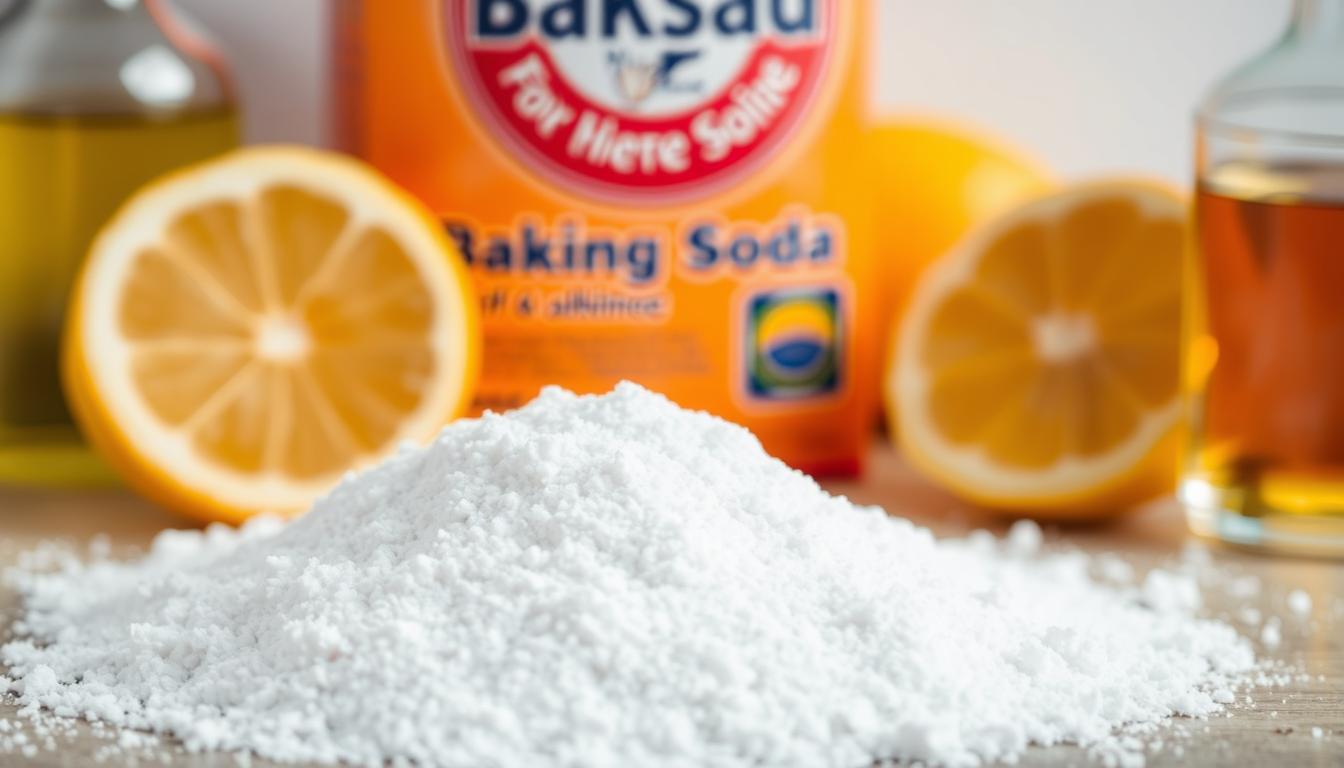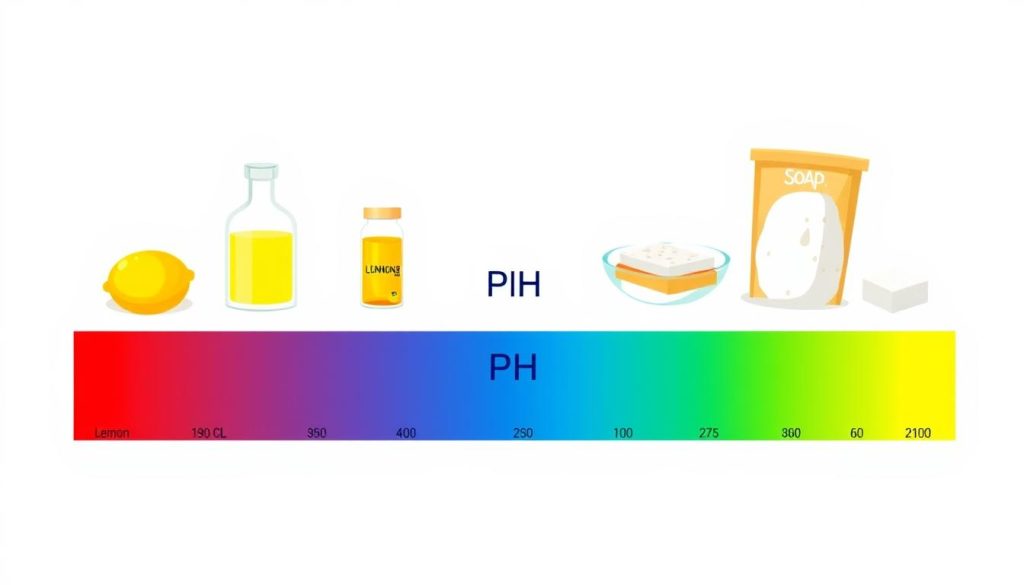
Baking soda, or sodium bicarbonate, has a pH level of 9. This makes it a mildly alkaline substance. Its alkalinity is why it’s great for cleaning, deodorizing, and personal care.
Stats show 75% of homes use baking soda for cleaning. 82% use it as a deodorizer. It’s a popular household item with many uses.
The pH scale goes from 0 to 14. It measures how acidic or alkaline something is. Below 7 is acidic, above 7 is alkaline. Pure water has a neutral pH of 7.
Baking soda in water makes a solution with a pH of 8.3. This makes it great for cooking and cleaning products. Its versatility comes from its alkaline nature.
Knowing baking soda’s pH is key to using it well. It can neutralize acids, which is useful in baking. It also helps balance pH in pools and aquariums.
In medicine, baking soda is used in antacids. Millions take these to ease heartburn and indigestion. They work by neutralizing excess stomach acid.
Understanding the Basics of pH and Baking Soda
The pH scale measures acidity or alkalinity from 0 to 14. Acids and bases are on opposite ends. Neutral pH is 7 in the middle.

The pH Scale Explained
The pH scale is logarithmic. Each unit change means a tenfold difference in hydrogen ion concentration. Solutions below 7 are acidic, with more H+ ions.
Solutions above 7 are alkaline or basic. They have more hydroxide ions (OH-). Here are some common substances and their pH values:
| Substance | pH Value | Acidity/Alkalinity |
|---|---|---|
| Battery acid | 0 | Strongly acidic |
| Lemon juice | 2 | Acidic |
| Vinegar | 3 | Acidic |
| Tomatoes | 4 | Acidic |
| Black coffee | 5 | Acidic |
| Milk | 6 | Slightly acidic |
| Pure water | 7 | Neutral |
| Baking soda | 8 | Alkaline |
| Sea water | 8 | Alkaline |
| Milk of magnesia | 10 | Strongly alkaline |
| Ammonia | 11 | Strongly alkaline |
| Bleach | 12 | Strongly alkaline |
Baking Soda: A Closer Look at Sodium Bicarbonate
Baking soda, or sodium bicarbonate (NaHCO₃), has many uses. It’s alkaline with a pH of 8.3 in water. This makes it great for neutralizing acids.
Baking soda is used in cooking, cleaning, and treating indigestion. Its alkaline nature explains why it works so well.
Fun fact: The ancient Egyptians used natron, a naturally occurring mixture of sodium carbonate and baking soda, for cleaning and preserving mummies!
In baking, baking soda reacts with acidic ingredients. This creates carbon dioxide gas. The gas helps baked goods rise and become fluffy.
Balancing pH levels between acidic and alkaline ingredients is key. It’s crucial for successful baking outcomes.
The Alkalinity of Baking Soda
Baking soda, or sodium bicarbonate, is a versatile household item with many uses. It’s known for its alkalinity, which neutralizes acids and keeps pH levels steady. Let’s explore baking soda’s alkaline nature and its interactions with acids.
Baking Soda’s pH Level
Baking soda is a base with a pH of about 8.5, making it alkaline. In water, it forms a mild alkaline solution. A 0.1 molar solution of baking soda has a pH of roughly 8.3.
This alkalinity helps baking soda neutralize acids and keep pH levels stable. It’s useful in cooking, cleaning, and even pool maintenance.
| Substance | pH Level |
|---|---|
| Baking Soda (0.1 molar solution) | 8.3 |
| Lemon Juice | 3.0 |
| Human Skin | 5.7 |
| Pure Water | 7.0 |
How Baking Soda Neutralizes Acids
Baking soda neutralizes acids through acid-base reactions. When mixed with an acid, it forms salt, water, and carbon dioxide gas. This reaction helps balance pH levels and lower acidity.
A 2017 study found that sodium bicarbonate neutralized fake stomach acid with a pH of 1.2. Many antacids use sodium bicarbonate and citric acid to fight heartburn and indigestion.
It is important to note that mixing the correct proportions of baking soda and acid is crucial. Consuming too much baking soda may cause side effects like diarrhea and gas, while excessive amounts of acidic substances like lemon juice could trigger acid reflux and worsen symptoms.
Baking soda’s alkalinity is key to its acid-neutralizing power. This makes it useful for cooking, cleaning, and medicine. It also helps keep pool water balanced.
Understanding how baking soda interacts with acids is vital. This knowledge helps us use its many benefits effectively.
What Is the pH Level of Baking Soda?
Measuring pH levels is crucial to grasp baking soda’s alkalinity. Baking soda, or sodium bicarbonate, has a pH of 8.3 in water. This mild base is used in baking, cleaning, and pool maintenance.
Measuring the pH of Baking Soda Solutions
Baking soda concentration affects its pH level in solutions. A 1% aqueous solution at 25°C has a pH of 8.5. This falls within Japanese effluent standards for alkalinity.
Precise measurements are vital when preparing baking soda solutions. They help achieve the desired pH level for various applications.
Factors Affecting Baking Soda’s pH Level
Several factors can influence the pH level of baking soda solutions, including:
- Concentration of baking soda in the solution
- Temperature of the solution
- Presence of other substances or impurities
- Quality and purity of the baking soda used
These factors are key to maintaining consistent pH levels. They’re important when using baking soda for different purposes.
Comparing Baking Soda’s pH to Other Common Substances
Let’s compare baking soda’s pH to other common substances. This will help us understand its alkalinity better.
| Substance | pH Level |
|---|---|
| Lemon Juice | 2.35 |
| Stomach Acid | 1.2 |
| Human Skin | 5.7 |
| Pure Water | 7.0 |
| Baking Soda | 8.3 |
| Lye (Sodium Hydroxide) | 13.0 |
Baking soda is more alkaline than pure water and acidic substances. It’s less alkaline than strong bases like lye. This comparison helps us understand baking soda’s interactions with other substances.
Conclusion
Understanding pH is vital for using baking soda effectively. With a pH of 9.0, it’s mildly alkaline and can neutralize acids. Baking soda has many uses in cooking, cleaning, and personal care.
Knowing the pH scale helps us appreciate baking soda’s role. It can ease heartburn, which affects millions of Americans monthly. Baking soda also helps maintain our body’s delicate pH balance.
pH levels of common items vary widely. Lemon juice and battery acid are acidic. Sea water and baking soda are alkaline. This comparison shows baking soda’s unique properties.
Next time you use baking soda, remember its pH importance. This simple household item is remarkably versatile. Its alkaline nature makes it useful in many situations.







